Definition of Visual Exchange in Track and Field
Sprint Relay
The aim of the 4 x 100 metres sprint relay is, with the assistance of four athletes, to carry a baton (30 cm long, 13 cm in circumference and no less than 50grms in weight) around 400 metres as quickly as possible.
Baton exchange
The rules of relay competition require the baton to be exchanged within a 20 metres change-over zone. So that the outgoing runner can achieve maximum acceleration at baton exchange, the athlete can commence his/her run 10 metres before the change-over zone. The baton exchange should occur 5 metres before the end of the change-over zone. Because of this, each athlete has to sprint more than 100 metres:
- 1st athlete 105 metres
- 2nd and 3rd athletes 125 metres
- 4th athlete 120 metres
Relay takeover zone change from 1st April 2018
Rule 170.3. In the 4 x 100m and the 4 x 200m relays and for the first and second exchanges in the Medley Relay, each takeover zone shall be 30m long, of which the scratch line is 20m from the start of the zone. For the third change in the Medley Relay and the 4 x 400m and longer relays, each takeover zone shall be 20m long of which the scratch line is the centre.
The acceleration zone has been eliminated for the 4 x 100m and 4 x 200m relays. These zones have been merged into one takeover zone 30m in length. Until the old markings are updated, the takeover zone will begin at the existing line marking the start of the acceleration zone. The scratch line remains in the same place but is now 20m after the beginning of the zone.
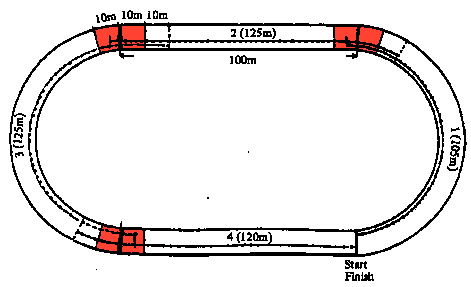
Checkmark
The exchange of the baton requires a matching of the speeds of the incoming and outgoing athletes so that they are together towards the end of the change-over zone. This requires the outgoing runner to commence his/her run when the incoming runner reaches a checkmark. The distance of the checkmark from the start of the zone needs to take into consideration the:
- running speed of the incoming runner
- reaction and acceleration capacity of the outgoing runner
The following is a general guide on the distance of the checkmark from the outgoing runner's starting point:
- Men - 7 to 9 metres
- Women - 6 to 7 metres
- Children - 5 to 6 metres
A more accurate calculation of the checkmark
Strict correspondence of speeds by the outgoing athlete and the incoming athlete within the passing zone is an essential condition of a successful change-over. Consequently, the optimum correlation of speeds of the athletes in the passing zone may be achieved using a precisely calculated checkmark.
Deciding on the position of the checkmark is a vital aspect of the relay running technique. For this, we put on the running track in front of the zone a checkmark. The moment of crossing the checkmark by the incoming athlete is the signal for the outgoing athlete to start running.
The method of deciding the position of the checkmark begins with establishing the exact spot of baton exchange (25 metres into the zone). We need to determine the:
- time the outgoing athlete takes to run 25m from a standing or modified crouch start, e.g. 3.24 seconds
- the time it takes the incoming athlete to run the last 25m of their leg, e.g. 2.25 seconds
- difference for the two athletes, e.g. 3.24 - 2.25 = 0.99 seconds
- average velocity of incoming athlete over the last 25 metres, e.g. 25 ÷ 2.25 = 11.11 m/s.
With the difference in time (0.99 secs) and the incoming athlete average velocity (11.11m/s) we can work out the checkmark as 11.11 x 0.99 = 10.99m
The reaction of the outgoing athlete to the incoming athlete hitting the checkmark also needs to be taken into consideration. Investigations with top-class athletes indicate that this reaction time is +0.20 seconds. By the time the outgoing athlete commences their running the incoming athlete will have travelled 0.20 x 11.11 m/s = 2.22 metres which will mean the outgoing athlete will begin from a shorter start of 10.99 - 2.22 = 8.77m rather than the calculated 10.99m. The checkmark, therefore, needs to be placed at 10.99 + 2.22 = 13.21m
Running line and baton exchange
The running position in the lane and exchange of the baton for each member of the relay team is as follows:
- the first runner carries the baton in the right hand and runs on the inside of the lane
- the second runner takes the baton in the left hand and runs closer to the outside of the lane
- the third runner takes the baton in the right hand and runs close to the inside of the lane
- the fourth runner takes the baton in the left hand
The exchange is non-visual. Once the outgoing athlete has seen the incoming athlete reach the checkmark, he/she will start as if reacting to the starting gun in a sprint race. The incoming athlete will call 'Hand' when he/she is in a position to safely pass the baton to the outgoing athlete. The outgoing athlete puts back his/her hand, the incoming athlete places the baton into the hand, and the exchange is complete. The outgoing athlete does not watch the baton into his/her hand, hence non-visual.
Starting Positions
1st Leg
The first athlete will use a sprint start and will have to modify the right-hand position to hold the baton securely. The athlete has the following options for holding the baton:
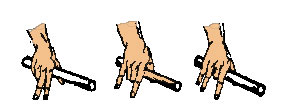
Other legs
The starting position for the outgoing athlete must allow for:
- explosive start and a fast acceleration
- good observation of the approaching incoming athlete
A possible start position for each outgoing athlete is as follows:
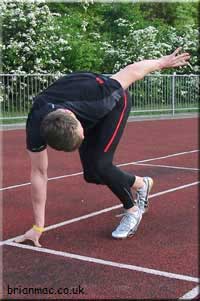
This is the start position for the 2nd and 4th leg runners. The 3rd leg runner will stand to the inside of the lane, use the left hand to support the body and watch for the incoming athlete under the right arm.
Passing Techniques
Upsweep
The receiving hand is extended behind them at hip height with the palm facing down and a wide angle between the thumb and the rest of the fingers. The incoming athlete passes the baton in an upward movement into the receiving hand.
The advantage of this method is that this is a standard position for the receiving hand. A disadvantage is that it may require some manipulation of the baton in hand to make the next exchange safely.
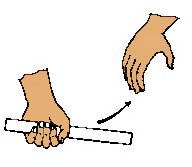
Downsweep
The receiving hand is extended behind them at hip height with the palm facing up and a wide angle between the thumb and the rest of the fingers. The incoming athlete passes the baton in a downward movement into the receiving hand.
The advantage of this method is that it will require no manipulation of the baton to make the next baton exchange safely. A disadvantage is that it is not a natural position of the outgoing athlete's hand to receive the baton.
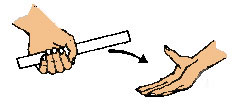

Push Pass Technique
The outgoing runner's arm is extended out behind them parallel to the ground, and the hand is open with the thumb pointing down. The incoming runner holds the baton vertically and pushes it straight into the open hand.

The advantage is the incoming runner can easily adjust the baton's position up, down or sideways and can observe the outgoing runner's hand take hold of the baton. It will require no manipulation of the baton by the outgoing runner to make the next baton exchange safely. A disadvantage is that it is not a natural position of the outgoing athlete's arm and hand to receive the baton. This is perhaps the safest method of baton exchange.
Selection of team members
The performance in the relay event primarily depends upon the perfection of the baton exchange and the sprinting ability of the team. For the selection of athletes for the different relay legs, it is sensible to find out their capacities for a particular section (the second and third runner cover longer distances). It also is advisable to establish each athlete's full potential for running sections on the straight and around the bend. These individuals' abilities must be considered in deciding the running order of a relay team, considering the following:
- The first leg - priority goes to an athlete who has a good start, can run the bend and pass the baton well
- The second leg - the choice goes to an athlete who is confident in receiving and passing the baton, runs well in the straight and possesses sufficient speed endurance. The athlete should perhaps be a 200 metres specialist.
- The third leg - the selection goes to the sprinter who is confident and reliable in receiving and passing the baton, can run the bend well and possess sufficient speed endurance. The athlete should perhaps be a 200 metres specialist.
- The fourth leg - here we normally select a runner who receives the baton well, is efficient in running the straight and has a high degree of competitive spirit.
Team order and exchange points
The following information on baton exchange for each leg of the relay and team order has been provided by Daniel Maas whose running resume includes being the 193rd American to run sub-four-minute/mile, 7 NAIA National Championships for Adams State College and 6 Events on US National teams.
If there are noticeable differentials in the speeds of the runners, it can be a good idea on the first leg to exchange 5 metres into the zone and then on the second leg to exchange 5 metres from the end of the zone and then on the third leg 5 metres from the beginning of the zone. This way your first leg runner goes 95 metres with the baton and hands off to your second fastest runner with a flying start. The athlete on the second leg then runs 110 metres carrying the higher speed. The third leg runner is the slowest and only goes 90 metres before giving the baton to the anchor (the fastest runner) to carry the baton 105 metres. With the running order of 3-2-4-1, it will maximize the distance the two fastest runners carry the baton.
I have seen a running order of 3-1-4-2 to give your fastest athlete a flying 110 metres with the baton. I have not personally run in a 3-1-4-2 order with differential lengths but seen it be effective. Certainly not as much at the collegiate and elite levels but it can be effective in high school where you can have significant speed differentials at each leg. I have also seen the team order approach used in the 4x400m relay.
Rules of Competition
The competition rules for this event are available from:
- International Association of Athletics Federations (IAAF)
- British Athletics
Page Reference
If you quote information from this page in your work, then the reference for this page is:
- MACKENZIE, B. (2001) Sprint Relay [WWW] Available from: https://www.brianmac.co.uk/sprints/relay.htm [Accessed
Definition of Visual Exchange in Track and Field
Source: https://www.brianmac.co.uk/sprints/relay.htm
0 Response to "Definition of Visual Exchange in Track and Field"
Post a Comment